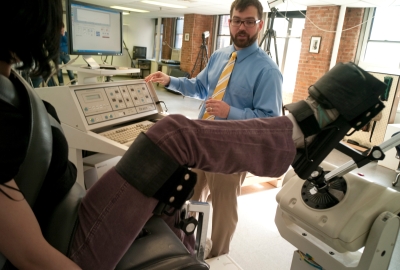
Clinical Affiliation
This clinical education component of the Doctor of Physical Therapy allows students to apply knowledge and skills learned in the classroom to real-life situations in a variety of settings (orthopedics, pediatrics, neurology, geriatrics, etc.), experiencing our wonderful profession first-hand, developing working relationships with practicing therapists, and perhaps even discovering what physical therapy specialization they might pursue after graduation.
In fact, these valuable experiences often lead directly to full-time employment upon graduation; many of our recent graduates now work at the facilities where they once attended clinic.
Clinic affiliations are full-time and take place each summer immediately following the spring semester. The time frames of these clinical affiliations are as follows:
- I - Seven weeks after your first year in the degree
- II - Eight weeks after the second year in the degree
- III - Eight weeks each at two sites after your third year in the degree
Currently, we affiliate with over 500 healthcare facilities across the nation. Students play an active role in selecting their sites, choosing from affiliated teaching hospitals, rehabilitation centers, schools, private practices, and skilled nursing facilities, thereby assuring a well-rounded clinical experience. If a student wishes to attend a site with which we are not presently affiliated, we will make all attempts to effectuate a relationship with that site.
Clinical Observation
This clinical education component of the Doctor of Physical Therapy program allows students to observe and be mentored by expert clinicians working in their respective specialized clinical settings. Students observe in small groups and see first-hand what it takes to become a highly-skilled, well rounded professional practitioner in conjunction with the specific system currently being studied in class (cardiovascular/pulmonary; musculoskeletal; neuromuscular; and genito-urinary, integumentary, endocrine, immune, and gastrointestinal), thus establishing a unique link between the didactic and clinical aspects of the program.
Clinical observations take place according to the following schedule:
- I - Fall semester, 2nd year (cardiovascular/pulmonary or musculoskeletal system)
- II - Spring semester, 2nd year (cardiovascular/pulmonary or musculoskeletal system)
- III - Fall semester, 3rd year (neuromuscular, genito-urinary, or integumentary system)
- IV - Spring semester, 3rd year (neuromuscular, genito-urinary, or integumentary system)
Observations are part-time (one day per week) and occur in stress-free, nurturing environments, allowing students to truly appreciate collaborative, problem-based learning in all aspects of the profession including examination, intervention, business, management, and professional behavior.
To ensure that our clinical observation program remains at the forefront of physical therapy education and establishes the best learning and working environment possible, our faculty carefully selects each participating clinician based on years of experience within their respective areas of specialization, and facilitate an open dialogue between student, master clinician, and faculty.